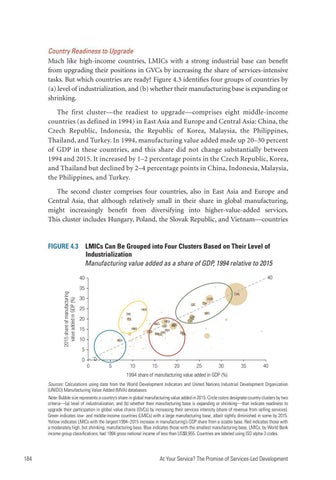Country Readiness to Upgrade Much like high-income countries, LMICs with a strong industrial base can benefit from upgrading their positions in GVCs by increasing the share of services-intensive tasks. But which countries are ready? Figure 4.3 identifies four groups of countries by (a) level of industrialization, and (b) whether their manufacturing base is expanding or shrinking. The first cluster—the readiest to upgrade—comprises eight middle-income countries (as defined in 1994) in East Asia and Europe and Central Asia: China, the Czech Republic, Indonesia, the Republic of Korea, Malaysia, the Philippines, Thailand, and Turkey. In 1994, manufacturing value added made up 20–30 percent of GDP in these countries, and this share did not change substantially between 1994 and 2015. It increased by 1–2 percentage points in the Czech Republic, Korea, and Thailand but declined by 2–4 percentage points in China, Indonesia, Malaysia, the Philippines, and Turkey. The second cluster comprises four countries, also in East Asia and Europe and Central Asia, that although relatively small in their share in global manufacturing, might increasingly benefit from diversifying into higher-value-added services. This cluster includes Hungary, Poland, the Slovak Republic, and Vietnam—countries
FIGURE 4.3 LMICs Can Be Grouped into Four Clusters Based on Their Level of Industrialization Manufacturing value added as a share of GDP, 1994 relative to 2015 40
40 2015 share of manufacturing value added in GDP (%)
35 CHN
30
KOR THA
CZE
25
HUN SVK
20
POL
15
VNM
10
MYS
IDN PHL TUR MEX BGD ARG EGY IND PER RUS PAK ZAF IRNCOL CHL
NGA
5 0
0 0
5
10
15
20
25
30
35
40
1994 share of manufacturing value added in GDP (%) Sources: Calculations using data from the World Development Indicators and United Nations Industrial Development Organization (UNIDO) Manufacturing Value Added (MVA) databases. Note: Bubble size represents a country’s share in global manufacturing value added in 2015. Circle colors designate country clusters by two criteria—(a) level of industrialization, and (b) whether their manufacturing base is expanding or shrinking—that indicate readiness to upgrade their participation in global value chains (GVCs) by increasing their services intensity (share of revenue from selling services). Green indicates low- and middle-income countries (LMICs) with a large manufacturing base, albeit sightly diminished in some by 2015. Yellow indicates LMICs with the largest 1994–2015 increase in manufacturing’s GDP share from a sizable base. Red indicates those with a moderately high, but shrinking, manufacturing base. Blue indicates those with the smallest manufacturing base. LMICs, by World Bank income group classifications, had 1994 gross national income of less than US$8,955. Countries are labeled using ISO alpha-3 codes.
184
At Your Service? The Promise of Services-Led Development

